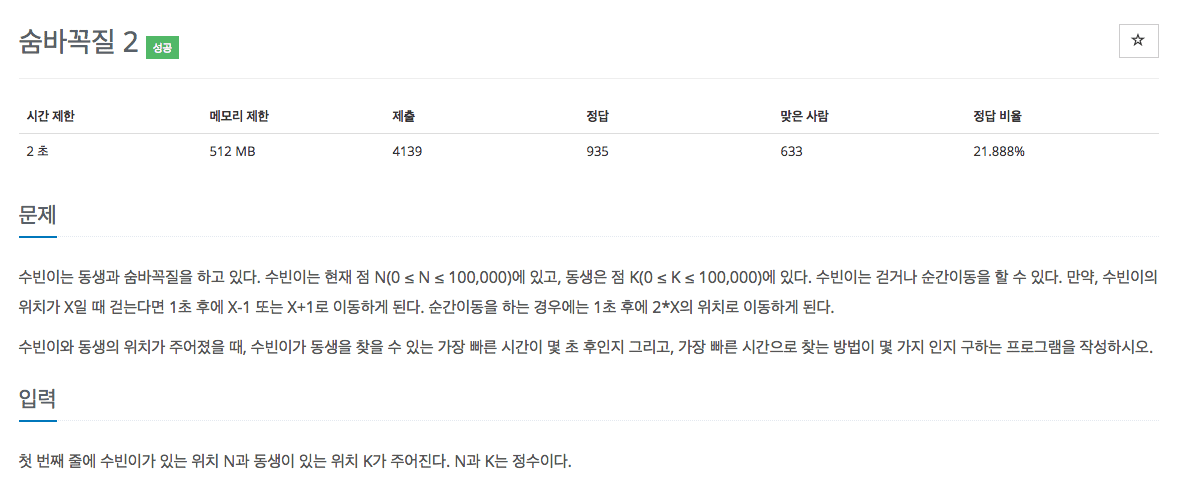Problem
Problem URL : 숨바꼭질2


[1] Answer Code (18. 09. 21)
#include <iostream>
#include <queue>
using namespace std;
int visit[100001];
int main(){
ios::sync_with_stdio(0);
cin.tie(0);
int st,dest;
cin >> st >> dest;
if( st == dest ){
// [1]
cout << "0" << '\n' << "1" << endl;
return 0;
}
queue<int> q;
q.push(st);
int time = -1;
int flag = 0;
while (! q.empty()) {
if( flag )
break;
time ++;
int size = (int) q.size();
for(int i=0; i<size; i++){
int top = q.front();
q.pop();
if( top == dest ){
flag ++;
continue;
}
/*
// [2]
if( visit[top] ) // Already Visit
continue;
*/
visit[top] = 1;
if( top - 1 >= 0 && !visit[top - 1] ) // Already Visit
q.push(top - 1);
if(top + 1 <= 100000 && !visit[top + 1] ) // Already Visit
q.push(top + 1);
if(top * 2 <= 100000 && !visit[top * 2] ) // Already Visit
q.push(top * 2);
} // end of for i
} // end of while
if( flag )
cout << time << endl << flag << endl;
return 0;
}
Review
-
시작점과 도착점이 같으면 0초인데 나는 1초로 해서 1시간 넘게 삽질했다.
-
문제를 똑바로 읽자 !!!
-
[2]을 넣게되면 다음과 같은 경우 틀리게 된다.
1 4 일 때
1 2 4
+ x
1 2 4
x x
/*
+로 된 2 값과
x로 된 2 값은
경로가 다르기 때문에 따로 처리해줘야한다.
하지만 [2] 주석을 풀게되면
+로 된 2를 먼저 처리하게되면
x로 된 2는 continue가 되어 문제가 발생한다.
*/
[2] Answer Code (18. 09. 23)
#include <iostream>
#include <queue>
#define p pair<int,int>
using namespace std;
int v[100001]; // v is visit
int main(){
ios::sync_with_stdio(0);
cin.tie(0); cout.tie(0);
int st, dest;
cin >> st >> dest;
queue<p> q;
q.push({st,0});
int ans = 0;
int ans_time = 2e9;
while (! q.empty()) {
int top = q.front().first;
int time = q.front().second;
q.pop();
if( time > ans_time )
break;
if(top == dest){
ans_time = time;
ans++;
continue;
}
v[top] = 1;
if( top + 1 < 100001 && !v[top+1] ){
q.push({top+1, time+1});
}
if( top - 1 > -1 && !v[top-1]){
q.push({top-1, time+1});
}
if( top * 2 < 100001 && !v[top*2]){
q.push({top*2, time+1});
}
}
cout << ans_time << endl;
cout << ans << endl;
return 0;
}
Review
if( time > ans_time )
break;
if(top == dest){
ans_time = time;
ans++;
continue;
}
-
문제가 요구하는 조건은 최단 시간과 최단 시간내 목적지까지 가는 경로의 수 이다.
-
그렇기 때문에 최단 시간 이후에 경우에 대해서는 볼 필요가 없다.
-
가지치기를 하기 위한 방법으로 현재 보는 시간(=time)이
이전에 목적지에 도달하여 재초기화된 시간(=ans_time)보다 클 경우에 Loop를 Break했다. -
이 조건이 가능한 이유는 다음 레벨의 값을 볼 때
이미 이전에 도착점에 도착한 경우가 있다면
정답의 레벨(=ans)은 현재 체크하려는 값의 레벨보다 낮을 것이다.
그렇게 되면 현재 체크하는 값이 목적지에 갈 수 있더라도 최단 시간이 될 수 없기 때문에 Loop를 탈출시켜도 된다. -
또한 같은 레벨에 대해서는
목적지에 도달하여 ans_time 값이 초기화되더라도
그 값은 같은 레벨에 대해서는 모두 같기 때문에 if( time > ans_time ) 종료 조건에 빠지지 않는다. -
즉 queue에 있는 같은 레벨에 모든 경우의 수를 체크 수 있게 된다.
1 -> 4 로 가는 경우라면
1 (+) 2 (+) 3
1 (+) 2 (*) 4
1 (*) 2 (+) 3
1 (*) 2 (*) 4 경우가 나올 수 있다.
이 때
Tree 구조로 생각하면
1
2 2
3(1) 4(1) 3(2) 4(2)
각 행에 끝에 있는
3(1) 4(1) 3(2) 4(2) 는 같은 레벨이다.
처음에 3(1)을 볼 땐 목적지가 아니기 때문에
3(1)이 갈 수 있는 3가지 조건에 대해 queue에 push를 해준다.
그리고 4(1)를 보면 목적지이기 때문에
ans_time을 2로 초기화해주고 ans++를 해준다.
그리고 continue이기 때문에 queue에서 pop을 해주면 3(2)이 나오게 된다.
이 때는 같은 레벨이기 때문에
if( time > ans_time ) 조건을 pass하게 되고
3(1)과 마찬가지로 갈 수 있는 3가지 경우를 queue에 push해준다.
그리고 4(2)를 pop하고 다시 ans_time을 2로 초기화해주고 ans++를 해준다.
여기까지 같은 레벨에 대한 체크가 끝났다.
이제 pop을 하는 값은 레벨이 다른 상태이고
그말은 목적지까지 도달할 수 있는 경우라 하더라도
기존에 답보다는 무조건 크게 된다.
그렇기 때문에 체크를 할 필요도 없이
if( time > ans_time ) 조건에 의해 while문을 빠져나간다.